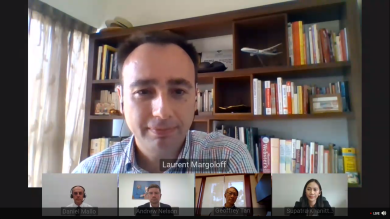Reports suggest that renewable energy scene warming up in Asia in a big way

In Asia, the innovations in investment structure, financing vehicles and emerging technology can accelerate energy transition came to the fore when stakeholders discussed the current scenario at the webinar titled, ‘Financing Dialogue: Renewable Energy Project Briefing in Southeast Asia’ held by Future Energy Asia.
The energy transition and low-carbon agenda occupies a significant portion of the overall developmental agenda in Asia including SEA (South East Asia), says Daniel Mallo, MD & Head-Energy, Infrastructure and metals & mining, Asia, SG-CIB. He explains: “It is a new area in South Asia and Asia-Pacific including Japan and Taiwan. In India, there is talk about accelerating energy and soon it will become a market. While it is stuck in Indonesia, Taiwan is showing the way. Vietnam might catch up soon. While nuclear energy is a low carbon solution, the difficulty in financing and nuclear waste are daunting. The industry has had issues in Europe, Finland, and France. There are examples how cost overrun the original budgets. Yet there are demand balances. Even at the peak of financial market disruptions, we have seen deals getting closed. What is required is fast tracking of land acquisition, power purchase agreement (PPA), procurement process, fast tracking regulations, and converting waste into energy. We have in the past seen solar catching up despite an early lag.”
Sharing his perspective on the financial push to renewable energy, Geoffrey Tan, Managing Director-Asia Pacific, US International Development Finance Corporation (DFC) emphasizes the local factors playing a critical role in different SEA markets. “While we talk about utility support by the state, tariffs and subsidies, there are many local requirements and constraints for the market to go forward. There is long term and medium term potential, depending on individual countries. With the situation getting better, the capital availability is improving. The markets have normalized since last year. Recently, DFC has collaborated with the Shell Foundation to build a pipeline of high impact businesses that deliver distributed renewable energy to households, farmers and businesses in off grid areas. Their contribution is 50 million dollars in capital which can be used in a number of ways such as viability gap funding, and technical feasibility studies. We have to understand that there is recognition for innovative and more aggressive approaches. Many investors are focused on existing green field projects. They have an appetite as there is no lack of capital but it is for likeable projects."
In most of the countries there is no open access to renewable energy sources except the solar panels which users are installing to fulfill their long term energy needs, Laurent Margoloff, Regional Lead for Utilities - Energy Asia Pacific at ING. "The hydrogen and batteries have witnessed many efforts. However, from the research stage to ready to hit the market, the capital constraints are many. The local currency, commercial terms, refinancing, and availability of liquidity are few issues. In Singapore, it’s a mix of clean technologies. It, along with Malaysia and Cambodia, is trying to impart good energy technologies and management practices. In Vietnam, we have seen a large number of users but at the same time there are constraints with grid flexibility, efficient energy, and green investment. In Australia, we have huge electricity production and steel industries. At this moment, a large-scale hydrogen project is being developed in the country. In the Netherlands, we are witnessing a big project on green nitrogen. The projects are expensive and not at the combustion stage. It hasn’t seen much demand. In the context of green hydrogen, the Western Australia has large scale hydrogen production and the local government is providing grants. The United Kingdom is encouraging it with schemes while Korea, China and Japan are building expertise for the future hydrogen economy and the supply chain. Offshore wind energy too is going strong in SEA.”
According to Wood Mackenzie's 2020 estimate, Asia will draw US $1.5 trillion in renewable energy projects over the next ten years. Providing country-wise reality check, Andrew Nelson, Director, Standard Chartered Bank says: “There are a number of ongoing projects in Australia. What we have seen is that customers are demanding renewable energy. There is good penetration of battery plus renewable projects. Yet the lack of encouraging policies hinder the progress as there are no incentives. There is a complicated financial element around private funding. Based on the things we have seen in Australia, there is some change but we need to leverage it. Among other countries, Taiwan is standing out in building capacity while South Korea and Japan too are making good progress. In Vietnam, we have seen activity picking up. It has good resources to create a sustainable renewable energy sector. There is 1,000 megawatt solar capacity and a lot of PPAs are available. Therefore, we need to get the market moving. In the Philippines, the development of institutions is going on. Its market needs liquidity and financing for the projects. There is a need to recognize solar and wind resources. Despite scarce sunlight and wind speed, there is potential. India has potential, especially in Coastal Gujarat. The speed of the energy transition and finance is an issue though.”
Nelson is of the opinion that a lot of global players are looking at Asia Pacific as an investment destination. Talking about Covid-19 pandemic's impact on the liquidity available for SEA renewable energy projects, he adds, “After Covid-19, large players in Europe are looking at Asian markets. Among the other sources of capital, banks and other financial institutions could play a significant role.”
Supatra Khanitthabut, Investment Specialist, Credit Guarantee and Investment Facility (CGIB), says there is an average of 10% increase in infrastructure annually and the only constraint is the lack of enough capital. “Security, safety and sustainability and environmental impact are the factors that will determine the future of renewable energy.”
Subscribe to our newsletter & stay updated.